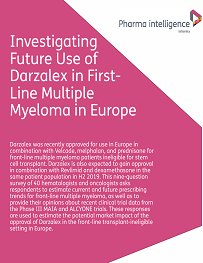Report Library
All Reports
Investigating Future Use of Darzalex in First-Line Multiple Myeloma in Europe
March 20, 2019
Darzalex was recently approved for use in Europe in combination with Velcade, melphalan, and prednisone for front-line multiple myeloma patients ineligible for stem cell transplant. Darzalex is also expected to gain approval in combination with Revlimid and dexamethasone in the same patient population in H2 2019. This nine-question survey of 50 hematologists and oncologists asks respondents to estimate current and future prescribing trends for front-line multiple myeloma, as well as to provide their opinions about recent clinical trial data from the Phase III MAIA and ALCYONE trials. These responses are used to estimate the potential market impact of the approval of Darzalex in the front-line transplant-ineligible setting in Europe.
If you are a KOL Insight Subscriber, please access the survey from our KOL Insight portal (Subscribers only).
Biomedtracker will be offering KOL Reports and Physician Pulse Surveys for purchase a la carte, or access to all reports and surveys can be purchased as a subscription to KOL Insight. For more information on KOL Insight subscription, please email Biomedtracker or call Biomedtracker Client Services at (858) 200-2357.
Survey Questions:
If you are a KOL Insight Subscriber, please access the survey from our KOL Insight portal (Subscribers only).
Biomedtracker will be offering KOL Reports and Physician Pulse Surveys for purchase a la carte, or access to all reports and surveys can be purchased as a subscription to KOL Insight. For more information on KOL Insight subscription, please email Biomedtracker or call Biomedtracker Client Services at (858) 200-2357.
Survey Questions:
- Screening Questions: (i) How many multiple myeloma patients are you currently treating? (ii) Have you previously treated multiple myeloma patients with Darzalex (daratumumab)? (iii) For how many years have you practiced as an onco-hematologist?
- Q1. Darzalex plus Velcade/melphalan/prednisone (DVMP) recently gained EMA approval in front-line transplant-ineligible patients based on the Phase III ALCYONE trial results. Do you consider these results to be practice-changing?
- Q2. In front-line transplant-ineligible patients, Darzalex plus Revlimid/dexamethasone (DRd) in the Phase III MAIA study demonstrated a strong effect on progression-free survival after 30 months; however, OS data are currently immature. Do you consider these results to be practice-changing?
- Q3. Which one of these regimens do you consider to be the most tolerable for front-line transplant-ineligible multiple myeloma patients?
- Q4. How important is tolerability when it comes to prescribing in this patient population? Please score from 1 to 5, with 1 being the most important.
- Q5. Which of these regimens do you consider to be the most efficacious in front-line transplant-ineligible patients?
- Q6. In a scenario where all the below regimens are approved and reimbursed, what percentage of your front-line transplant-ineligible patients will you be treating with each of these regimens within 2–3 years’ time?
- Q7. MAIA is the third study of Darzalex in newly diagnosed patients to have met its primary endpoint. In what line of therapy for the treatment of multiple myeloma do you ultimately expect Darzalex to be used most frequently (assuming the therapy is reimbursed in all patient populations)?
- Q8. Please rank these clinical endpoints in order of importance for determining therapeutic value in front-line transplant-ineligible patients (if reaching statistical significance)?
- Q9. Do you consider minimal residual disease (MRD) negativity to be a suitable surrogate for overall survival in multiple myeloma?
| Indications Covered: | Multiple Myeloma (MM) |
